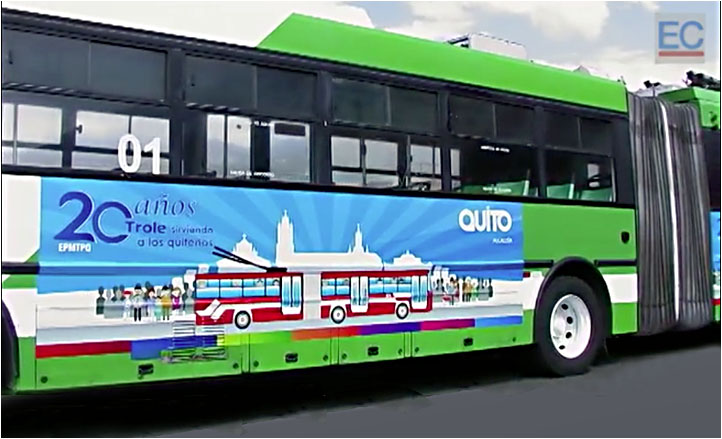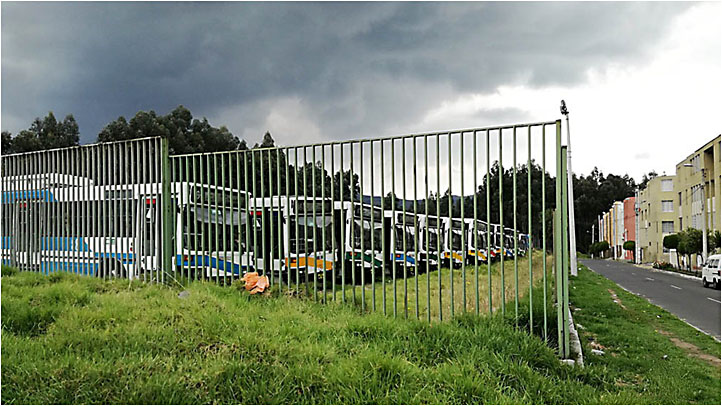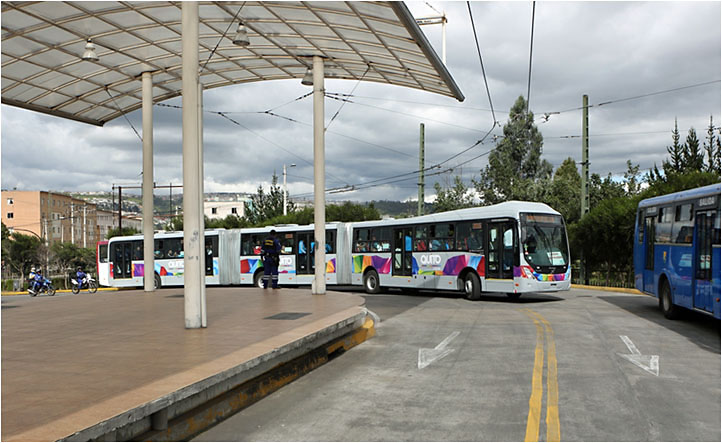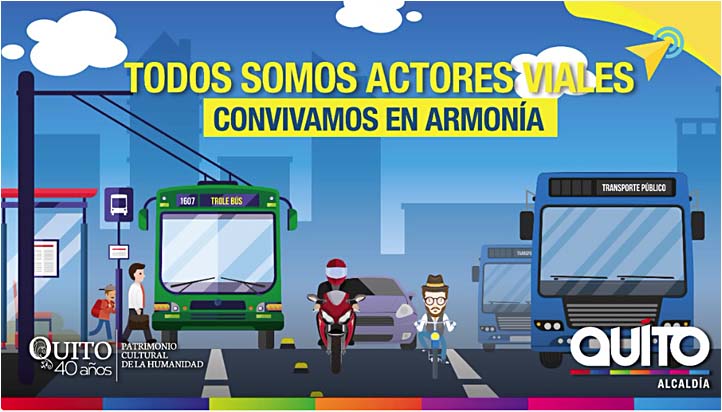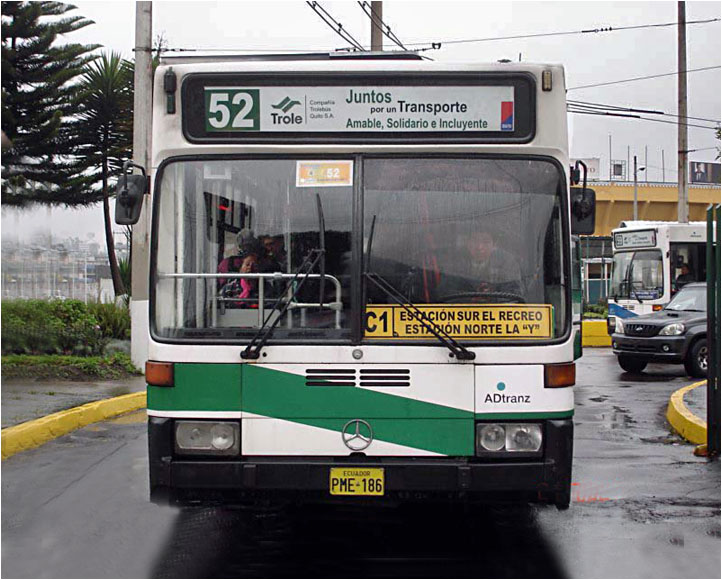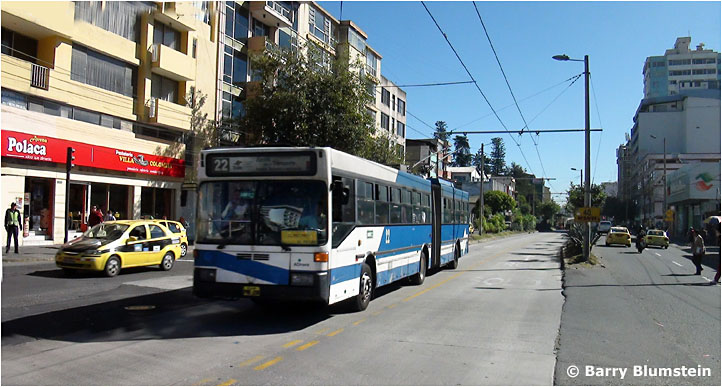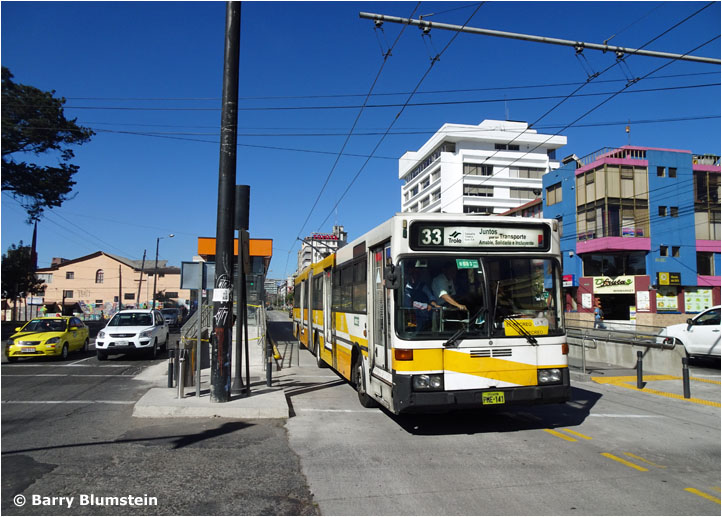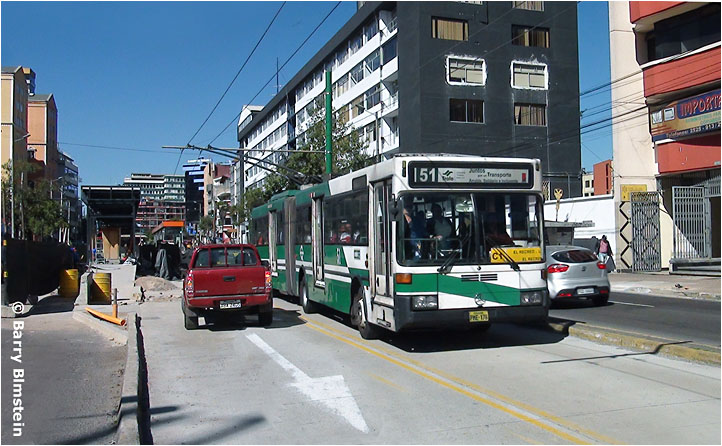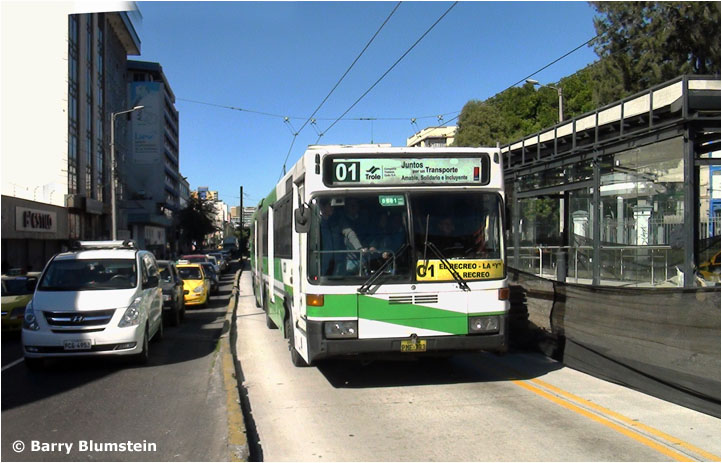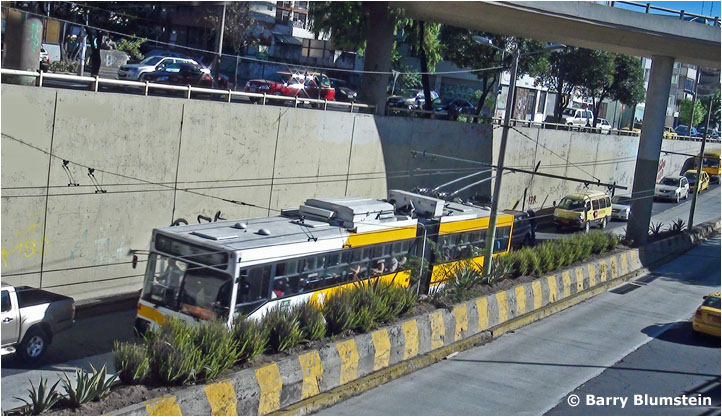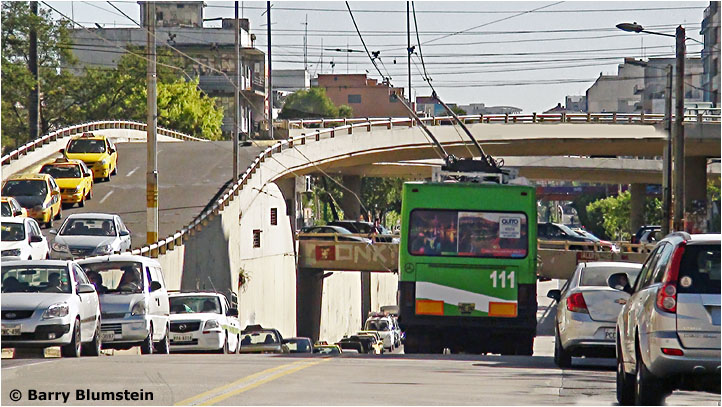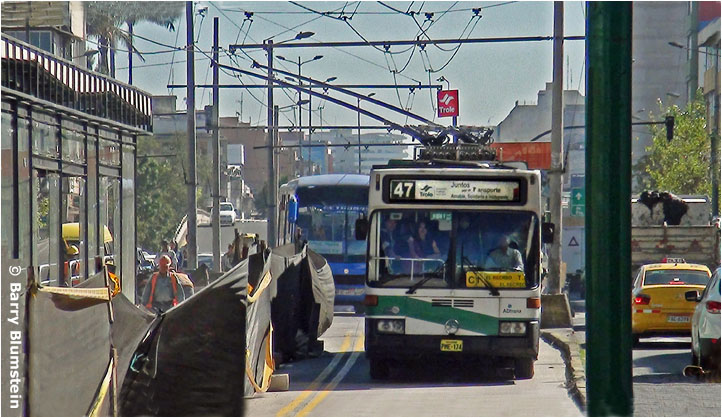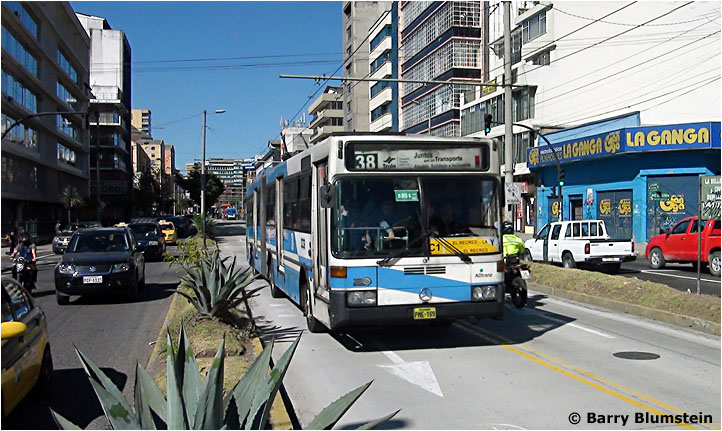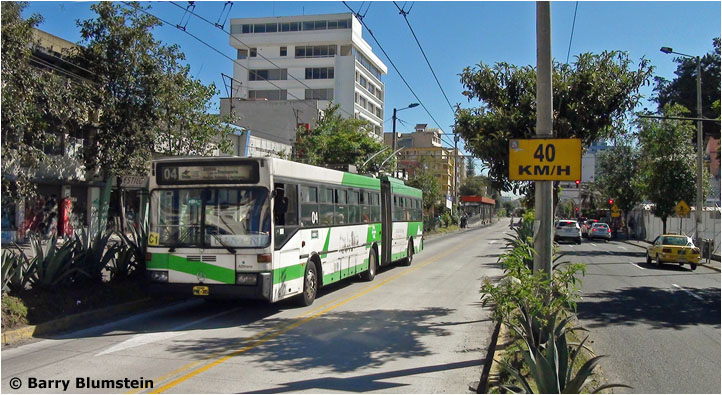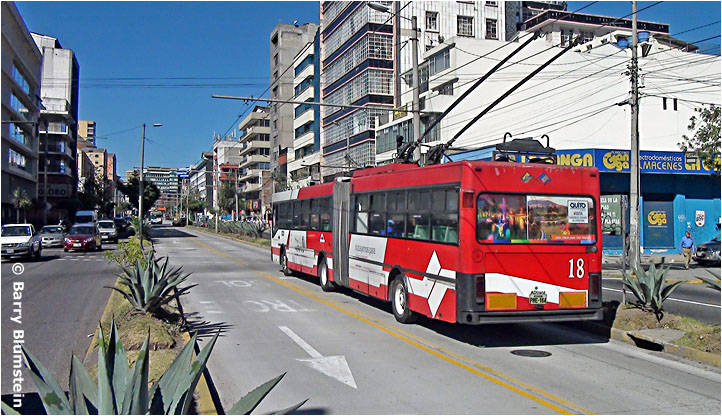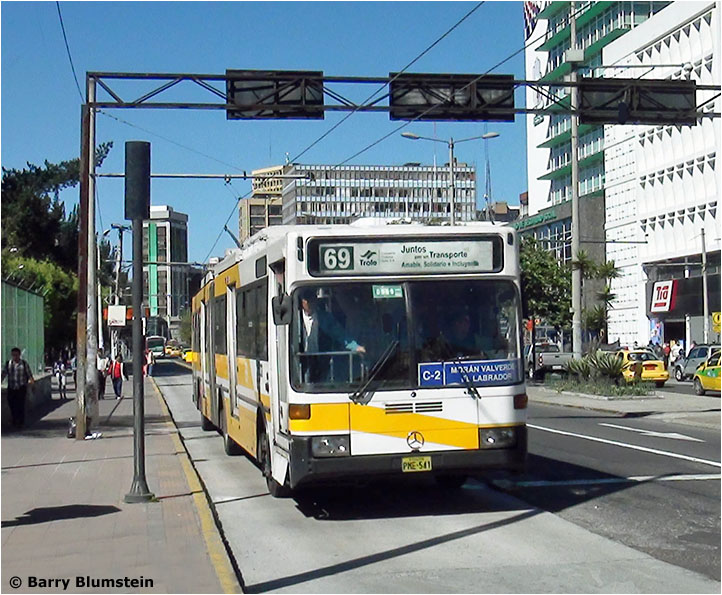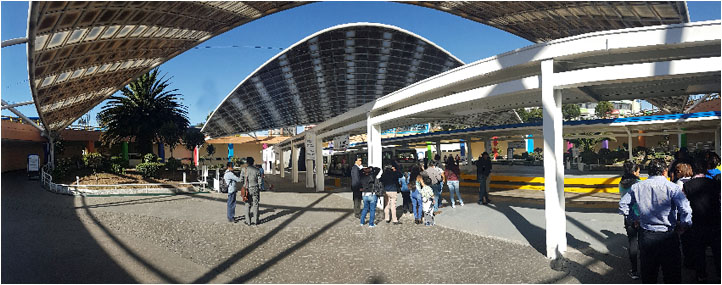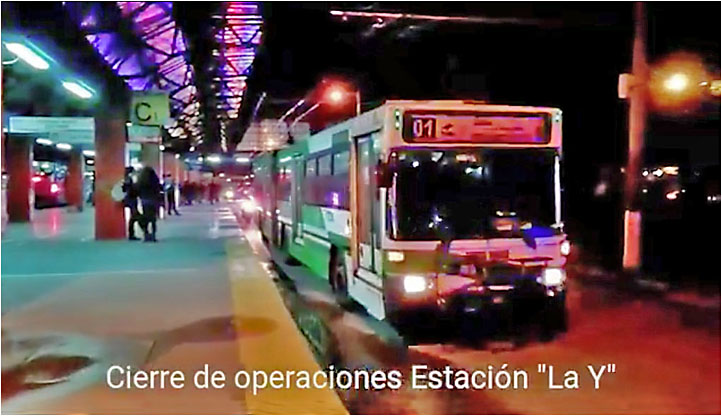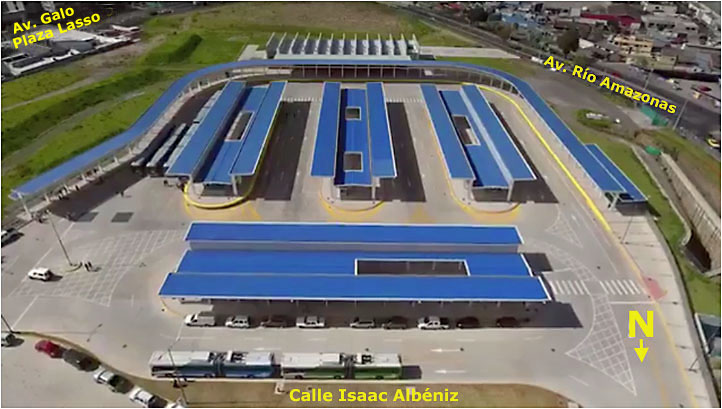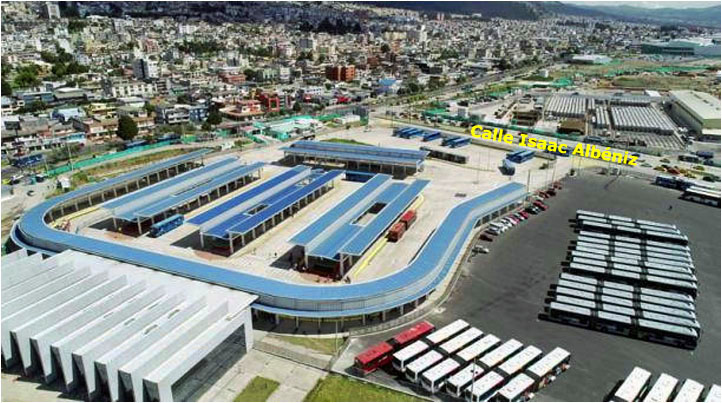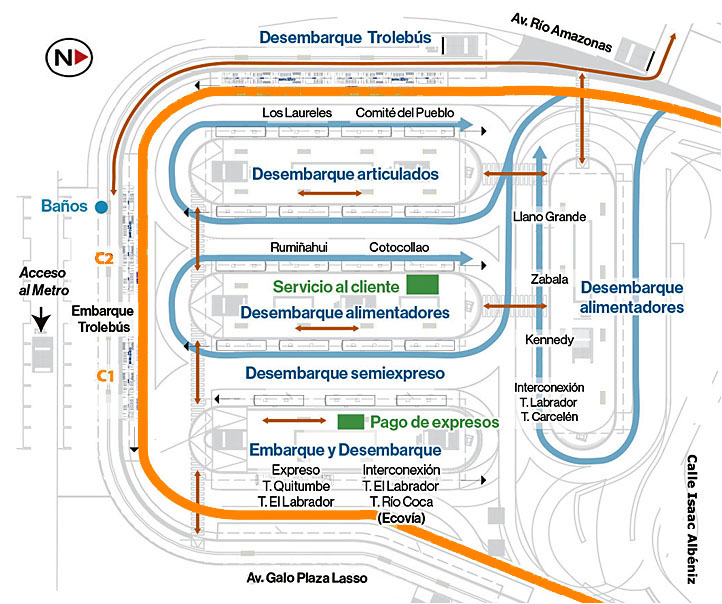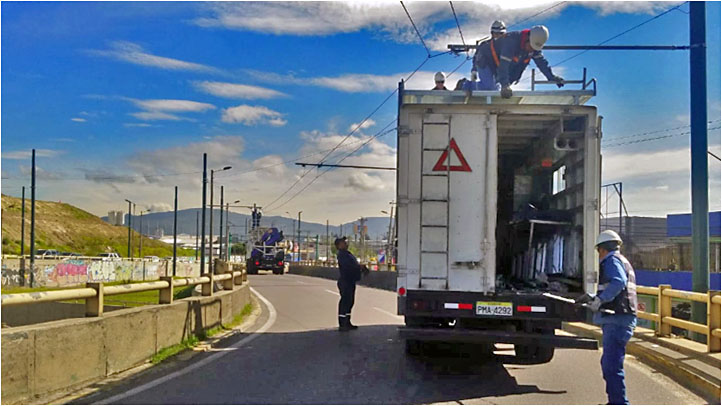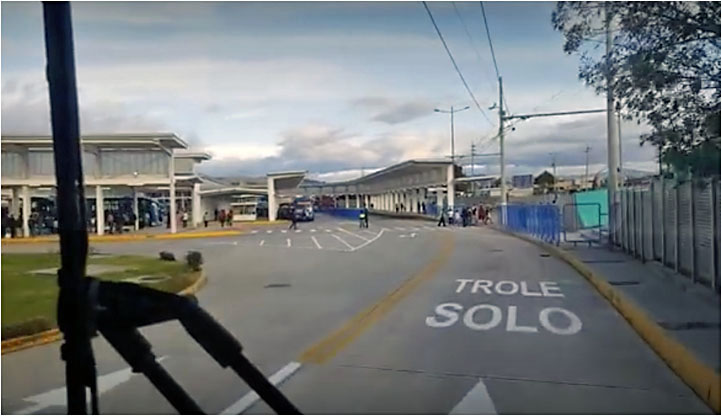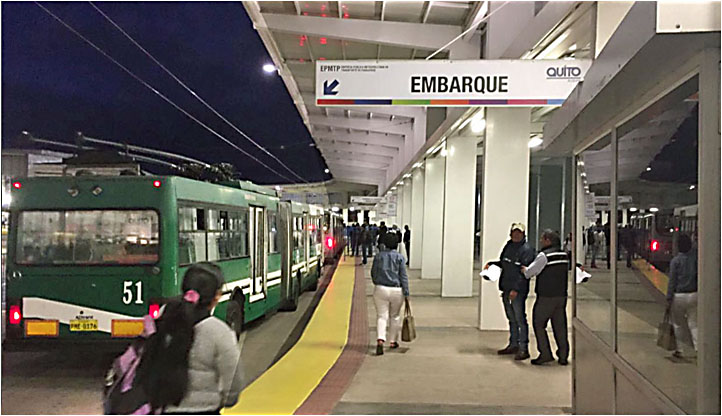El Trole / Los Trolebuses de
The Trolleybus System of
QUITO, ECUADOR
BY
Allen Morrison
|
Part 4: "El Trolebús", El Labrador
[Go to Part 1: Introduction, Av. 10 de Agosto]
By 2016,
the number of operable trolleybuses had shrunk to about 60. The others were
either scrapped or abandoned in yards about town:
Because of
the shortage, diesel buses were added to "El Trolebús"
– as the corridor once reserved for trolleybuses is now known. This diesel-powered Volvo biarticulado is arriving at Terminal Quitumbe [see map]:
In order to accommodate the longer vehicles, all the paradas
were rebuilt. But the new platform doors and levels did not match well
and passengers complained of gaps. The city responded with this
poster: "We're all transport actors. Let us live together in harmony." Is it referring to the passengers or the vehicles?
In any case, the city's original Spanish-built electrics held their own.
Thanks in large part to city planner César Arias, who has
promoted and defended the Quito trolleybus program since its inception
in the 1990s, most of the surviving vehicles have been kept in good condition and
still form the backbone of the local transportation system:
The
following 11 photographs were taken by Australian enthusiast Barry
Blumstein during a brief visit on Friday 5 August 2016. He
unfortunately had time to photograph only along Av. 10 de
Agosto in the hotel district north of the Centro Histórico [see map]:
Quito
trolleybuses are painted either dark blue, yellow, dark green, light
green, light blue or red. All liveries are shown om this page!
Some of the photographs show detours along the route as the paradas were rebuilt with longer platforms. In the view below
both the automobile and the trolleybus are temporarily running "the wrong way" because
of the construction in the distance:
Another detour because of parada reconstruction. Trolleybus #01, on circuito C1, will eventually run on the other side of the station:
The recessed by-pass near La Pradera metro station [see map]:
Confounding motorists, trolleybuses take advantage of their carril exclusiva at this spaghetti junction:
Another detour for construction of a longer loading platform. Note diesel bus behind:
The destination signs on this aging trolleybus could be better...
A trolleybus in "El Trolebús" reservation, used by both trolleybuses and diesel buses:
Had Mr. Blumstein had time to explore further, he would have discovered several interesting developments. On 27 May 2016, three months before his visit, the Empresa de Pasajeros de Quito de-electrified the entire 7.5 km southern end of the trolleybus line – all operation south of Estación Sur [see map]. The change was made to eliminate the treacherous left-hand operation against traffic between Estación Sur and Morán Valverde [see Part 3]. The new diesel buses that shared "El Trolebús" had doors on both sides, so were not affected. But after that date trolleybuses could no longer go to Terminal Quitumbe. Overhead wire was removed between Quitumbe and Morán Valverde, but not between Morán Valverde and Estación Sur, a fact that permitted trolleybus
route C2 to provide
a new express service like no other. (Even though the picture below was taken in
August 2016, the vehicle was strangely signed for El Labrador, a new terminal that did not yet exist.)
2013 was a critical year in Quito: (1) construction began in January of a 22 km north-south heavy-rail metro line; (2) Quito's airport – located a short distance from Estación Norte – closed in February. Aviation activity was transferred to a new airport 18 km east of the city and the old grounds became the new Parque Bicentenario. The northern terminus of the metro, which plans to begin operation in July 2019, will be at a large new multimodal terminal called El Labrador at the southern end of the park [see map]. Most bus services, including "El Trolebús", established their new termini there when the new facility opened on Friday 1 June 2018. Estación Norte closed, but a new parada called Plaza de Toros opened on Av. 10 de Agosto nearby (the bull ring is behind Estación Norte). Trolleybus #01 was the last vehicle to leave Estación Norte on Thursday night 31 May:
The trolleybus entrance to El Labrador is on Av. Galo Plaza Lasso (continuation of Av. 10 de Agosto) a kilometer north of Estación Norte [see map]. Trolleybuses turn west onto Calle Isaac Albéniz, then south onto a 500 m loop around a long curving platform. Smaller platforms in the center are for feeder bus lines. The photographer was facing south:
Another view of El Labrador, this time facing northwest [see map]. Note both 2- and 3-section articulated buses parked on the right. The large white structure lower left will be the mezzanine of the underground metro station:
Diagram
with west at the top. The mustard-colored line is "El Trolebús" route for both
trolleybuses and diesel buses that use the trolleybus lanes: Desembarque (unloading, arrival) and Embarque (boarding, departure). Alimentadores are (diesel) feeder bus lines:
Overhead wire was strung between Estación Norte and Calle Isaac Albéniz, then around the loop at El Labrador [see map]:
Terminal El Labrador was formally inaugurated on Friday 1 June 2018:
Until
installation and activation of the new wire was complete, trolleybuses
continued to use their auxiliary diesel motors between Estación
Norte and El Labrador:
There have
been several plans in
recent years to acquire new trolleybuses to supplant the aging fleet.
EPMTP wanted to make its central corridor – "El Trolebús"
– 100%
electric and pollution-free again. In February 2018 it began the
process of soliciting permission and funds from the government and
in April 2018 posted tenders for the purchase of 50 trolleybuses and 20
"buses articulados eléctricos" (powered by batteries)...
==========================================
DIGITOGRAPHY "Quito Informa" Mayor's homepage with information on various topics, including transportation. SSC forum on local transportation issues (There seems to be no SkyscraperCity forum specifically about Quito trolleybuses.) "Transporte de Pasajeros" Instagram page has many photographs, some also seen on the Twitter page below. "Transporte de Pasajeros" Twitter page that was a major source of information and photographs on this website.
In
addition to the items cited above, the author wishes to thank John
Kirchner, César Arias, Steve Morgan, Ricardo Yanes, Humberto
Gilmer and – of course, especially – Barry Blumstein for their contributions and assistance in the preparation of this page.
|
[Go to Part 1: Introduction, Av. 10 de Agosto]
[Go to Part 2: Centro, Av. Maldonado]
[Go to Part 3: "Trolesur", Quitumbe
See my index of
ELECTRIC TRANSPORT IN LATIN AMERICA
If you have comments, criticism or suggestions,
please write to Allen Morrison! Leo y escribo español.
This site was placed online on
15 July 2018
Copyright © 2018-2118 Allen Morrison
ALL RIGHTS RESERVED
TODOS LOS DERECHOS RESERVADOS
